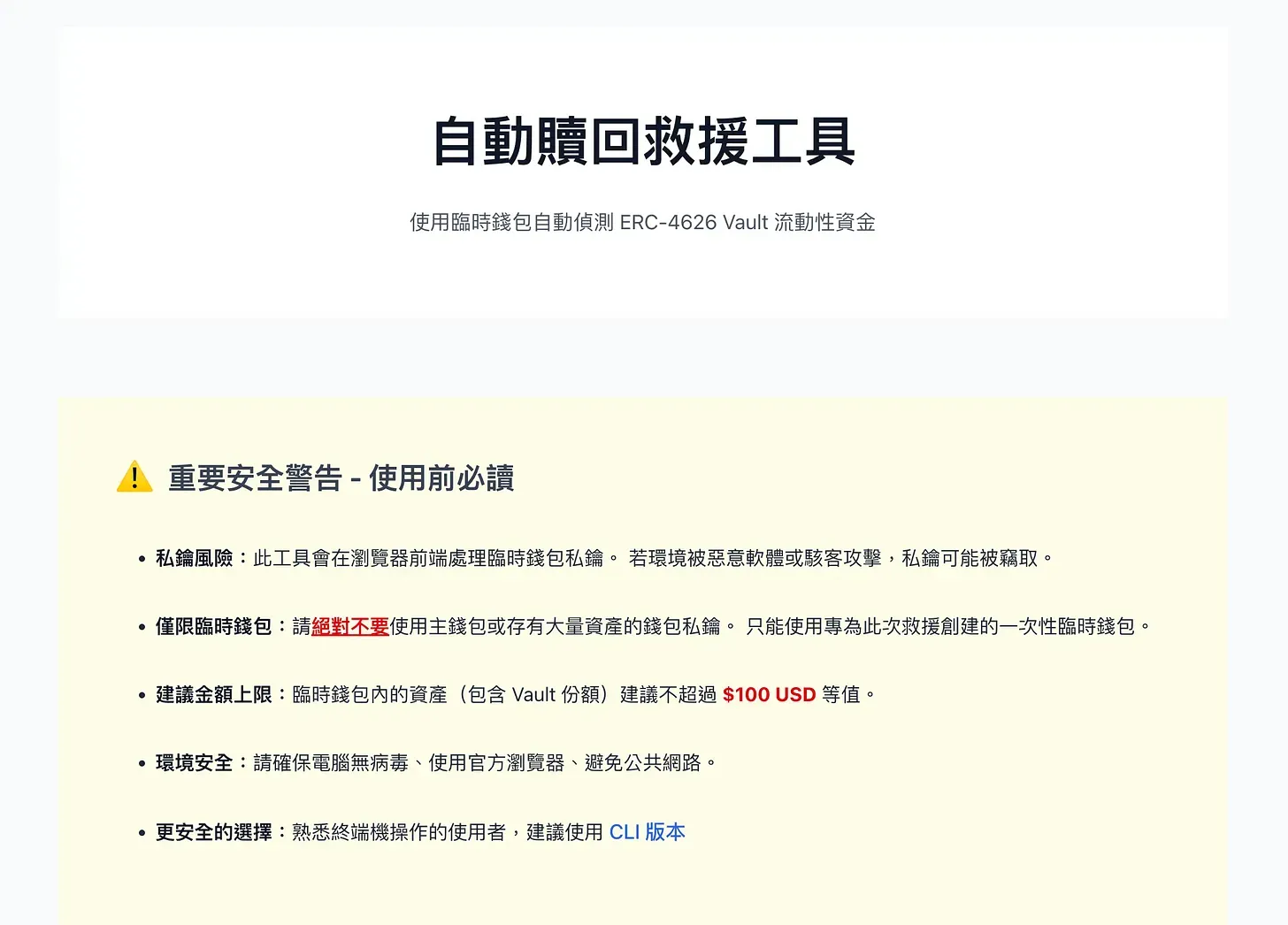DeFi Automatic Rescue Bot Is Live! An Open-Source Relay Collaboration for One-Click Fund Recovery

GM,
This article concerns the public interest and is fully open — feel free to share it. As mentioned in recent Blocktrend articles, last week I discovered that two of my assets were stuck in DeFi services 1 2 3 :
- Euler Finance (K3 USDT Earn Vault – Avalanche)
- Silo Finance (xUSD/USDC – Arbitrum)
The Euler Finance position was luckily rescued, saving me about US$7,000 in tuition fees. I want to give special thanks to Sun, founder of DeFiHackLabs, and Anton from the ETHTaipei community, both of whom offered tremendous help immediately. Anton dove straight into vibe coding, writing an automated rescue tool that let a bot monitor on-chain activity and redeem my assets. This allowed me to focus on completing the article — and a few hours later, I successfully withdrew everything.
Over the past few days, many people experienced exactly what I did — thinking that the Balancer hack and Stream Finance bad debt had nothing to do with them, only to find their funds stuck when trying to withdraw. Anton’s tool has already rescued quite a few people’s assets. But the original version had no front-end interface and required command-line operation — a high barrier for most users. The good news is: there’s now a web version. Below, I’ll explain how to use the tool, and then share the open-source relay story behind it.
The DeFi Automated Rescue Bot Is Live
There are currently two front-end websites available for the DeFi automated rescue bot. You can choose whichever interface you prefer (so luxurious!). Both versions were built independently by two different developers. The underlying functionality is the same, I’ve personally tested them, and they do work. The code is also open-source, so anyone can inspect it for risks or vulnerabilities.

The principle behind the DeFi Automated Rescue Bot is simple. It continuously monitors on-chain activity for a designated vault. As soon as it detects new liquidity entering the vault, it immediately triggers a “redeem” transaction on your behalf, converting your vault shares back into the underlying assets and automatically sending them to the wallet address you specify.
To use it, you only need to prepare:
- A temporary wallet: Used solely for running this task to avoid exposing the private key of your main wallet
- Vault address: For example, vaults from Euler, Silo, or other protocols
- RPC URL: Corresponding to the blockchain you’re operating on, such as Avalanche or Arbitrum
- Receiving wallet address: Where the redeemed assets will be transferred
After pressing “Start,” the bot begins monitoring automatically. Once the vault is replenished with liquidity, it will instantly execute a redemption ahead of others; if no liquidity is added, the bot will simply keep waiting for the next opportunity. You can stop it at any time. The entire process requires no manual intervention — no need to stare at your browser.
When the incident first broke last week, any liquidity added to the vault was drained within 30 seconds. I remember thinking, “Are these people not sleeping at all?” Now, with this bot, none of them stand a chance against you. You can go on with your life and leave the most stressful work to the machine.

If you run into any issues while using the tool, feel free to leave a comment at the end of the article, or contact the developers directly — Anton, GCAKE, or Rick from OneSavieLabs. They are the unsung heroes behind the DeFi Automated Rescue Bot.
Open-Source Relay Collaboration
Right after the incident happened, I complained to Sun, the founder of DeFiHackLabs 😂. He suggested using Cielo Finance’s free Telegram bot to monitor on-chain activity. Whenever there was any movement in the vault, I would receive a Telegram notification and could then manually execute the redemption. It still required manual action, but at least I didn’t have to keep refreshing the webpage nonstop.

Later on, Anton built the DeFi Automated Rescue Bot and fully automated this entire workflow. He first asked how much I still had stuck, then immediately jumped into vibe coding. Within just an hour, he delivered the first working version. It allowed me to monitor on-chain activity in the background while continuing my work. A few hours later, all my funds were fully redeemed — making mine the very first assets the bot ever rescued!
A few days later, more and more people realized they had unknowingly become DeFi victims and began messaging me about how to use the tool to retrieve their funds. Since most people had no idea how to operate a command-line bot, I posted in the community: “If anyone is willing to help build a frontend so people who don’t understand the command line can also use it, please contact me.”
I immediately received four messages. Three developers volunteered to build a web frontend based on Anton’s code, and another person offered to sponsor the effort financially.

The developer of the Chinese webpage, GCAKE, moved the fastest — he finished the first version that very night and successfully deployed it. The next day, he even wrote a detailed user guide so that people unfamiliar with coding could use it easily. But he also joked that the initial interface was “kind of ugly,” since he had only just begun learning vibe coding and wasn’t familiar with CSS.
Unexpectedly, community member Brian immediately picked up the baton. Building on the open-source codebase, he added security warnings and revamped the layout, making the interface both safer and much nicer.
Meanwhile, Rick from OneSavieLabs worked in parallel. Using the same core codebase, he built an English version of the interface and added RPC settings, real-time prompts, and step-by-step guidance to the frontend.
In just one day, what originally could only run via command-line operations turned into two complete web applications. Others also jumped in to review the code, improve the security warnings, and refine the usage instructions. No one discussed division of labor — it was pure open-source collaboration. One person after another contributed, turning the tool into something anyone could use. My role now, by writing this article, is to help spread the tool and make it freely available to anyone who needs it.
The Power of Community
In the past few days, a certain KOL posted on social media mocking people affected by the DeFi incidents — claiming they were greedy for entrusting their principal in exchange for yield. The post even quoted lines from my articles, clearly implying me. To be honest, that post sent my heart rate through the roof. How could someone use other people’s misfortune and pain as a way to get attention?

Let’s think about it this way: if he wasn’t intentionally being hurtful, then it simply means our understanding of risk is fundamentally different. He views risk as a “mistake that must be avoided,” believing that if something goes wrong, it must mean poor judgment. That’s why he uses the tone of, “See? I told you this stuff is dangerous,” urging people to stay away from risk and protect their assets.
But to me, cryptocurrency has never been wealth to hoard in a wallet — it has always been a tool to use. Of course I care about financial stability, but “getting rich from crypto” holds no appeal for me. I actually use crypto in daily life, then write about these experiences and share them with everyone. That’s what makes it fun, and that’s what gives me a sense of accomplishment.
Because I enjoy getting hands-on, no matter how careful I am, it’s inevitable that I’ll sometimes step on landmines and get hurt. But that’s part of practicing what you preach. Experience is the price I pay — and it can become nourishment for others. That’s why I write about the pitfalls I encounter: to remind those who, like me, are willing to try new things, and hopefully inspire better approaches that make the ecosystem safer.
Critics treat risk as the end point, but practitioners see risk as the starting point. Critics care about being right, using disasters to prove their correctness. But people who take action want to make things better — even if mistakes happen along the way. That doesn’t mean taking action was wrong.
This collaborative experience with the DeFi automatic rescue bot only strengthened my belief. If you don’t participate, you won’t face risks; if you never leave the house, you’ll never get into a car accident. Some people prefer to stay home — but I choose to step out bravely.
1 After Losing a Million in DeFi, My Wife Weighed In! What Did Netizens Say?
3 Decentralized Exchange Balancer Hacked! A Chain Reaction of Fires and a DeFi Confidence Crisis




